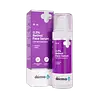What's inside
What's inside
 Key Ingredients
Key Ingredients

 Benefits
Benefits

 Concerns
Concerns

 Ingredients Side-by-side
Ingredients Side-by-side

Water
Skin ConditioningEthylhexyl Methoxycrylene
Skin ConditioningDiethylhexyl Carbonate
EmollientEthoxydiglycol
HumectantGlycerin
HumectantTetrahexyldecyl Ascorbate
AntioxidantDimethylmethoxy Chromanol
AntioxidantPhysalis Angulata Extract
Skin ProtectingCaprylic/Capric Triglyceride
MaskingCyclopentasiloxane
EmollientPhenyl Trimethicone
Skin ConditioningDimethiconol
EmollientC12-15 Alkyl Benzoate
AntimicrobialDimethicone Crosspolymer
Emulsion StabilisingHydroxyethyl Acrylate/Sodium Acryloyldimethyl Taurate Copolymer
Emulsion StabilisingPhenoxyethanol
PreservativeEthylhexylglycerin
Skin ConditioningMethyl Glucose Sesquistearate
EmollientBehenyl Alcohol
EmollientTrisodium Ethylenediamine Disuccinate
Pentylene Glycol
Skin Conditioning4-T-Butylcyclohexanol
MaskingPentaerythrityl Distearate
EmulsifyingBHT
AntioxidantRetinol
Skin ConditioningPolysorbate 20
EmulsifyingSodium Metabisulfite
AntioxidantWater, Ethylhexyl Methoxycrylene, Diethylhexyl Carbonate, Ethoxydiglycol, Glycerin, Tetrahexyldecyl Ascorbate, Dimethylmethoxy Chromanol, Physalis Angulata Extract, Caprylic/Capric Triglyceride, Cyclopentasiloxane, Phenyl Trimethicone, Dimethiconol, C12-15 Alkyl Benzoate, Dimethicone Crosspolymer, Hydroxyethyl Acrylate/Sodium Acryloyldimethyl Taurate Copolymer, Phenoxyethanol, Ethylhexylglycerin, Methyl Glucose Sesquistearate, Behenyl Alcohol, Trisodium Ethylenediamine Disuccinate, Pentylene Glycol, 4-T-Butylcyclohexanol, Pentaerythrityl Distearate, BHT, Retinol, Polysorbate 20, Sodium Metabisulfite
Water
Skin ConditioningButylene Glycol
HumectantGlycerin
HumectantBetaine
HumectantSorbeth-30
EmulsifyingRetinyl Palmitate
Skin Conditioning3-O-Ethyl Ascorbic Acid
Skin ConditioningPrunus Amygdalus Dulcis Seed Extract
Skin Conditioning1,2-Hexanediol
Skin ConditioningHydroxyacetophenone
AntioxidantAllantoin
Skin ConditioningPEG-40 Hydrogenated Castor Oil
EmulsifyingCarbomer
Emulsion StabilisingAminomethyl Propanol
BufferingPanthenol
Skin ConditioningXanthan Gum
EmulsifyingDisodium EDTA
Sodium Hyaluronate
HumectantCyclohexane
SolventCaprylic/Capric Triglyceride
MaskingPolyglyceryl-10 Myristate
Skin ConditioningPEG-15 Glyceryl Stearate
EmulsifyingOctyldodecanol
EmollientTocopheryl Acetate
AntioxidantPentylene Glycol
Skin ConditioningLecithin
EmollientIsononyl Isononanoate
EmollientParfum
MaskingHydrolyzed Rice Protein
Skin ConditioningHydrogenated Lecithin
EmulsifyingBHT
AntioxidantPhenoxyethanol
PreservativeTetrasodium EDTA
Benzyl Benzoate
AntimicrobialWater, Butylene Glycol, Glycerin, Betaine, Sorbeth-30, Retinyl Palmitate, 3-O-Ethyl Ascorbic Acid, Prunus Amygdalus Dulcis Seed Extract, 1,2-Hexanediol, Hydroxyacetophenone, Allantoin, PEG-40 Hydrogenated Castor Oil, Carbomer, Aminomethyl Propanol, Panthenol, Xanthan Gum, Disodium EDTA, Sodium Hyaluronate, Cyclohexane, Caprylic/Capric Triglyceride, Polyglyceryl-10 Myristate, PEG-15 Glyceryl Stearate, Octyldodecanol, Tocopheryl Acetate, Pentylene Glycol, Lecithin, Isononyl Isononanoate, Parfum, Hydrolyzed Rice Protein, Hydrogenated Lecithin, BHT, Phenoxyethanol, Tetrasodium EDTA, Benzyl Benzoate
 Reviews
Reviews

Ingredients Explained
These ingredients are found in both products.
Ingredients higher up in an ingredient list are typically present in a larger amount.
BHT is a synthetic antioxidant and preservative.
As an antioxidant, it helps your body fight off free-radicals. Free-radicals are molecules that may damage your skin cells.
As a preservative, it is used to stabilize products and prevent them from degrading. Specifically, BHT prevents degradation from oxidation.
The concerns related to BHT come from oral studies; this ingredient is currently allowed for use by both the FDA and EU.
However, it was recently restricted for use in the UK as of April 2024.
Learn more about BHTThis ingredient is an emollient, solvent, and texture enhancer. It is considered a skin-softener by helping the skin prevent moisture loss.
It helps thicken a product's formula and makes it easier to spread by dissolving clumping compounds.
Caprylic Triglyceride is made by combining glycerin with coconut oil, forming a clear liquid.
While there is an assumption Caprylic Triglyceride can clog pores due to it being derived from coconut oil, there is no research supporting this.
Learn more about Caprylic/Capric TriglycerideGlycerin is already naturally found in your skin. It helps moisturize and protect your skin.
A study from 2016 found glycerin to be more effective as a humectant than AHAs and hyaluronic acid.
As a humectant, it helps the skin stay hydrated by pulling moisture to your skin. The low molecular weight of glycerin allows it to pull moisture into the deeper layers of your skin.
Hydrated skin improves your skin barrier; Your skin barrier helps protect against irritants and bacteria.
Glycerin has also been found to have antimicrobial and antiviral properties. Due to these properties, glycerin is often used in wound and burn treatments.
In cosmetics, glycerin is usually derived from plants such as soybean or palm. However, it can also be sourced from animals, such as tallow or animal fat.
This ingredient is organic, colorless, odorless, and non-toxic.
Glycerin is the name for this ingredient in American English. British English uses Glycerol/Glycerine.
Learn more about GlycerinPentylene glycol is typically used within a product to thicken it. It also adds a smooth, soft, and moisturizing feel to the product. It is naturally found in plants such as sugar beets.
The hydrophilic trait of Pentylene Glycol makes it a humectant. As a humectant, Pentylene Glycol helps draw moisture from the air to your skin. This can help keep your skin hydrated.
This property also makes Pentylene Glycol a great texture enhancer. It can also help thicken or stabilize a product.
Pentylene Glycol also acts as a mild preservative and helps to keep a product microbe-free.
Some people may experience mild eye and skin irritation from Pentylene Glycol. We always recommend speaking with a professional about using this ingredient in your routine.
Pentylene Glycol has a low molecular weight and is part of the 1,2-glycol family.
Learn more about Pentylene GlycolPhenoxyethanol is a preservative that has germicide, antimicrobial, and aromatic properties. Studies show that phenoxyethanol can prevent microbial growth. By itself, it has a scent that is similar to that of a rose.
It's often used in formulations along with Caprylyl Glycol to preserve the shelf life of products.
Water. It's the most common cosmetic ingredient of all. You'll usually see it at the top of ingredient lists, meaning that it makes up the largest part of the product.
So why is it so popular? Water most often acts as a solvent - this means that it helps dissolve other ingredients into the formulation.
You'll also recognize water as that liquid we all need to stay alive. If you see this, drink a glass of water. Stay hydrated!
Learn more about Water